Unit 6 Topic 3 (I will remember our friendship forever)教案1(仁爱英语九年级下)
- 格式:doc
- 大小:195.50 KB
- 文档页数:19

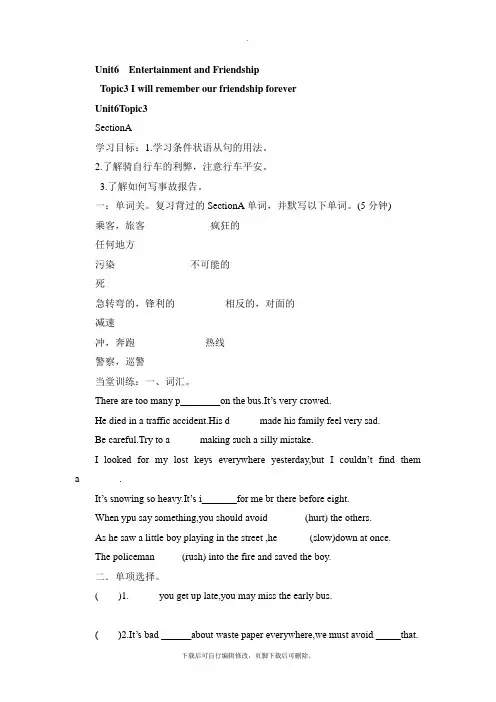
Unit6 Entertainment and FriendshipTopic3 I will remember our friendship foreverUnit6Topic3SectionA学习目标:1.学习条件状语从句的用法。
2.了解骑自行车的利弊,注意行车平安。
3.了解如何写事故报告。
一:单词关。
复习背过的SectionA单词,并默写以下单词。
(5分钟)乘客,旅客_____________疯狂的_____________任何地方______________________污染_______________不可能的_______________死___________________________急转弯的,锋利的__________相反的,对面的___________减速__________________冲,奔跑______________热线________________警察,巡警_____________________当堂训练:一、词汇。
There are too many p________on the bus.It’s very crowed.He died in a traffic accident.His d______made his family feel very sad.Be careful.Try to a______making such a silly mistake.I looked for my lost keys everywhere yesterday,but I couldn’t find them a________.It’s snowing so heavy.It’s i_______for me br there before eight.When ypu say something,you should avoid _______(hurt) the others.As he saw a little boy playing in the street ,he ______(slow)down at once.The policeman _____(rush) into the fire and saved the boy.二.单项选择。
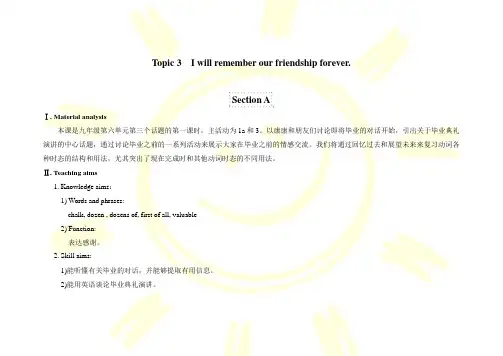
Topic 3 I will remember our friendship forever.Section AⅠ. Material analysis本课是九年级第六单元第三个话题的第一课时,主活动为1a和3。
以康康和朋友们讨论即将毕业的对话开始,引出关于毕业典礼演讲的中心话题,通过讨论毕业之前的一系列活动来展示大家在毕业之前的情感交流。
我们将通过回忆过去和展望未来来复习动词各种时态的结构和用法,尤其突出了现在完成时和其他动词时态的不同用法。
Ⅱ. Teaching aims1. Knowledge aims:1) Words and phrases:chalk, dozen , dozens of, first of all, valuable2) Function:表达感谢。
2. Skill aims:1)能听懂有关毕业的对话,并能够提取有用信息。
2)能用英语谈论毕业典礼演讲。
~初中英语精品资源~3. Learning strategies:抓住一切机会用英语和老师、同学和朋友进行交流。
Ⅲ. The key points and difficult points1. Words and phrases:chalk, dozen, dozens of, first of all, valuable2. Sentences:1) Take it easy. We have worked so hard that we will be able to pass it easily.2) Thinking back on the past three years, I have learned that if I want to succeed, I must study hard.3) Nothing is impossible if you set your mind to it.Ⅳ. Teaching aids多媒体课件,康康和同学们讨论的图片,装饰教室的图片,礼物的图片,拍照的图片,贺卡的图片。
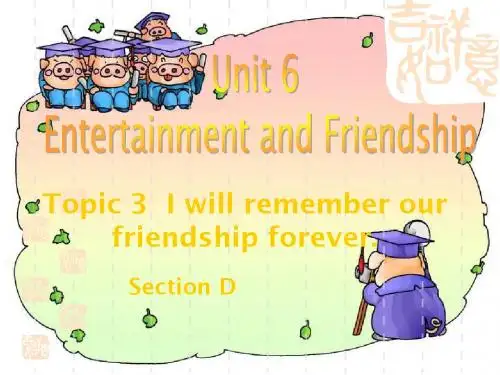
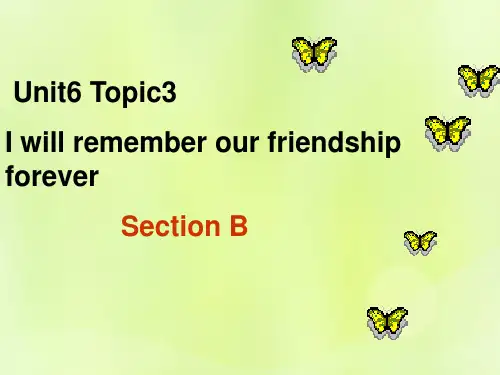
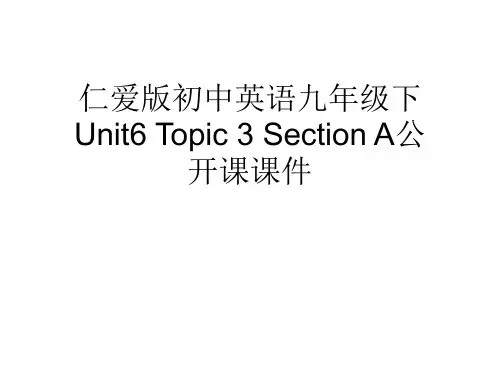
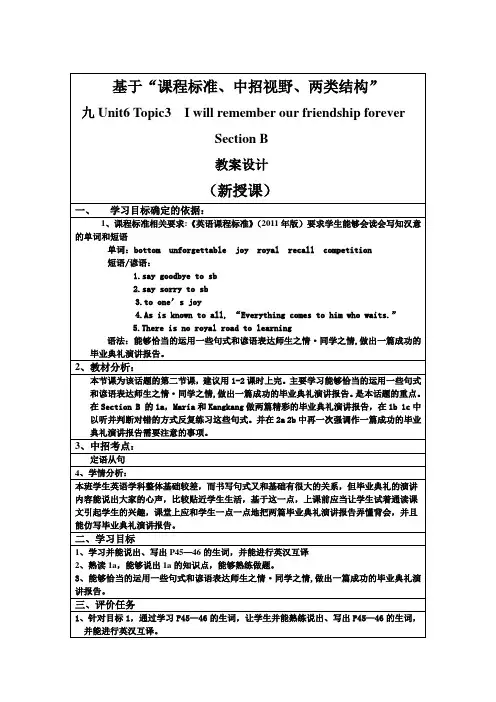
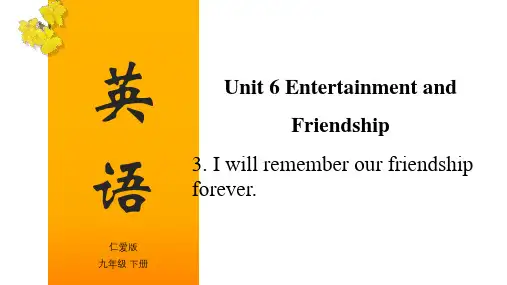
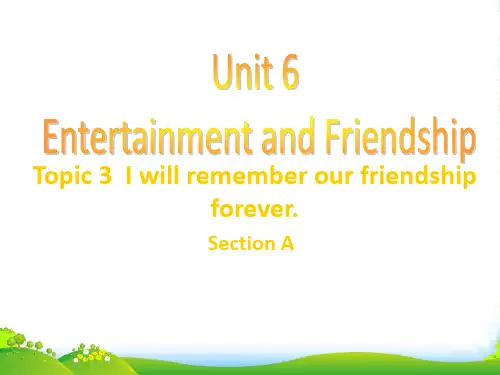
初中学习网-中国最大初中学习网站Czxxw.com | 我们负责传递知识! Unit 6 Entertainment and Friendship Topic 3 I will remember our friendship forever
Section A The main activities are 1a, 3a and 3b. 本课重点活动是1a, 3a和3b。 Ⅰ. Teaching aims and demands教学目标 1. Master some new words and phrases: chalk, handwriting, dozen, dozens of, cheap, package, smooth, pound, dollar, penny 2. Learn what to do before leaving school and learn to write a speech at graduation ceremony: (1)...there is going to be a graduation ceremony. (2)...first of all, we must pass our final examination. (3)be ready for graduation ceremony Ⅱ. Teaching aids教具 教学磁带/录音机/画有英镑、美元和便士的卡片/含有Auld Lang Syne的歌曲磁带/布包 Ⅲ. Five-finger Teaching Plan五指教学方案
Step 1 Review 第一步 复 习(时间:15分钟) 1. (播放Auld Long Syne歌曲营造一种离别的气氛,创造真实的语言学习环境,唤起学生的思维。) T: Boys and girls, do you know the song? What’s the name? Ss: Auld Lang Syne. T: That’s right. We listened to it in Junior Eight. Could you tell me what it is about? Who will try? OK, S1. S1: It is about the feeling when people say good-bye.Is it right? T: You are completely right. We often hear the song at the end of some activities. How time flies! Soon, we’ll finish our school, that is to say, we’ll graduate from school soon. (老师慢读graduate,并且重读几遍,让学生了解其意义和学会其读音。) 2. T: If we hold a graduation ceremony (graduation ceremony means a meeting or a party for graduation, in Chinese means “毕业典礼”), and write best wishes in English. What will you write? Write it on a piece of paper soon. (此活动可激活学生已有的知识,也可引出下面的一些新单词。老师选出有深意的几份,其中有一份的字非常漂亮。) T: Now, I collect some of yours. T: S2, could you read the slogans for us?
S2: No problem. S3: says,“Let’s our friendship last forever.” S4: says, “We are the owners of future.” S5: says, “It’s lucky of us to have the days with you.” S6: says, “I would rather lose the world than have no news of you.” 3. (导入新单词。) 初中学习网-中国最大初中学习网站Czxxw.com | 我们负责传递知识!
T: Thank you , S2. How wonderful you all are, my friends! This job seems a piece of cake for you. (教师抽出其中最漂亮的一份。) T: Look at S5’s slogan. How beautiful his handwriting is! S5, could you design your slogan with some pictures on the blackboard with some colorful chalk before the graduation ceremony? (教师在讲述时用相应的物体,通过直观法呈现新单词,并依次板书。) S5: Of course, I am glad to. T: Thank you, S5. I’ll give you a gift ahead, but you must guess what it is. Listen carefully. It’s round and long and smooth and its length is about six centimetres. We use it to write every day. What’s it? S5: A pen. T: Yes, it is. The pen is cheap. It only costs 6 yuan. But as the saying goes, it’s the thought that counts. It means“礼轻情意重”. T: The gift is in my package. Here it is! Here you are, S5. I wish your handwriting become more and more beautiful. S5: Thank you very much. (教师从包里取出画有英镑、美元和便士的图片。依次呈现给学生。以轻松幽默的语气继续导入生词。) T: Look. There are some pictures of foreign paper money, I’ll get dozens of gifts for you with the money if you study English well. This is English money, a pound, this is American or Australian money, a dollar and this is a penny. a piece of cake: something easy to do handwriting n. package n. dozens of a dozen=twelve chalk n. a piece of chalk pound n. a pound≈1.54 dollars≈12 yuan smooth adj. dollar n. a dollar≈8 yuan cheap adj. penny n. pound=100 pence
(依次板书划线部分生词,标出音标,领读几遍,用彩色粉笔标出需注意的问题,如单、复数形式。领读几遍后,让学生自己练习几遍。)
T: Can you remember all the new words and phrases? Is it a piece of cake? Ss: Of course, it is.
Step 2 Presentation 第二步 呈现(时间:10分钟) 1. (呈现毕业前的一般的活动,进入1a。)
I bought two/a few dozen eggs dozens of roses in the market. 初中学习网-中国最大初中学习网站Czxxw.com | 我们负责传递知识!
T: Class, can you tell me how soon will you graduate? Ss: About five months. T: What have you thought you will do before leaving school, S1? S1: We must study hard to pass the final examination. T: What about you, S2? S2: We should leave the telephone numbers and addresses. T: Do you think if there is going to be a ceremony? Ss: Yes, we think so. T: Turn to 2 on Page 41. Discuss with your partner. Check what you will do before leaving school. (学生分组讨论,抽查部分学生的答案。) T: S3, what will you do? S3: I’ll take photos of everyone, prepare for my examination and have a class get-together. T: S4, how about you? S4: I’ll give presents to everyone and prepare gifts for teachers. T: Stop discussion. Now, look at the picture on Page 41. Kangkang and some others are talking with each other. Let’s listen to the tape to see what they are talking about. Then answer my questions. (播放课文对话磁带。) T: Can you follow the dialog? Ss: Yes, we can. T: Now, some tasks for you. S5, please. When will they graduate? S5: This weekend. T: Question 2. What does Michael think of the final examination? S6,please. S6: He thinks it’s a piece of cake. T: Question 3. What will Kangkang say at the graduation ceremony? S7: He will say he has learned not only how to study, but also how to be an adult. T: Well done! 2. (进入3a。) T: We learn there are many activities we’ll do before leaving school. If we hold a graduation ceremony, what will be done? S8: Write a slogan on the blackboard and draw some pictures on it. S9: We’ll talk about our friendship and our plan. S10: We’ll give presents to each other. S11: ... ... T: Your ideas sound very good! We go on listening what Miss Wang and the students are talking about. (播放课文3a的教材内容。教师把下列阅读任务写在黑板上。) Answer the following questions according to 3a: (1) Who will design and write on the blackboard?